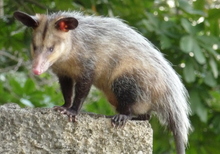As horses are turned out into spring time pastures, horse owners may want to watch out for any signs of opossums especially in wooded areas or near streams. Opossums are the definitive hosts of the protozoal parasites that cause Equine Protozoal Myeloencephalitis (EPM).

Opossum - Definitive host of protozoal parasite
After the horse eats the sporocyst in the opossum feces, it travels to the horses' central nervous system and causes lesion or damage to the spinal cord resulting in the symptoms of EPM.
© 2013 by Wolfman
Equine Protozoal Myeloencephalitis or EPM is a neurologic disease of the horse caused by two kinds of parasites. These parasites are Sarcocystis neurona and Neospora hughesii. Many horses are exposed to the parasite, but it is estimated that only approximately 1% of horses are effected by EPM.
Known as the great imitator because it can mimic lameness and other neurologic diseases in the horse because it affects the spinal cord and nerves that come off the spinal core that control motor function or muscle movement.
The opossum is the definitive host of these protozoal parasites. A definitive host is the host in which a parasite reaches maturity. There are many intermediate hosts including raccoons, skunks and armadillos. The intermediate hosts harbors the parasite for a short period of maturation.
The horse is an aberrant host, which means it is not the normal host for the organism and the organism can not develop normally and complete itsâ development. The parasite develops into a sarcocyst in the skeletal muscle of the intermediate host and is then ingested by the definitive host of the opossum. In the digestive tract of the opossum the sarcocyst develops into a sporocyst.
The sporocyst is the phase that is infective to the horse. The sporocyst is found in the opossum feces. In order for the horse to become infected with EPM, it ingests the opossum feces. Typically from eating hay, but it can be from the pasture or grain as well.
After the horse eats the sporocyst, the sporocyst then travels to the horsesâ central nervous system and causes lesion or damage to the spinal cord. The damage to the spinal cord is what causes the signs that you, as an owner see in your horse.
How do I find out if my horse has EPM?
FIrst, a complete neurologic exam by your veterinarian needs to be performed. Next, your horse can be tested for EPM. EPM tests can be done on cerebral spinal fluid or on blood. Obtaining spinal fluid in the horse can be difficult and has risks associated with it, so a highly sensitive and specific blood test is desired. All of the tests are antibody tests.
What do I do if my horse has EPM?
According to Dr. Stephen Reed formerly of The Ohio State University College of Veterinary Medicine, the prognosis for horses with EPM seems to be similar regardless of the treatment used: 60 â 75% of horses improve on standard therapy.
Unfortunately, less than 25% of affected horses return to their original function. While a number of medications have come on and off the marketâand many continue to use the combination of trimethoprim/sulfaâthere are currently only two FDA-approved medications for the treatment of EPM Ponazuril (Marquis®) and Diclazuril (Protazil). A third which is currently in the process of receiving FDA approval is Oroquin 10. This new medication combines two older drugs, levamisole and decoquinate.
Equine Protozoal Myeloencephalitis is a frightening disease for both horse owner and horse. The symptoms in themselves are frustrating and confusing and the outcome is far from assured in any case.
Read more about Equine Protozoal Myeloencephalitis
